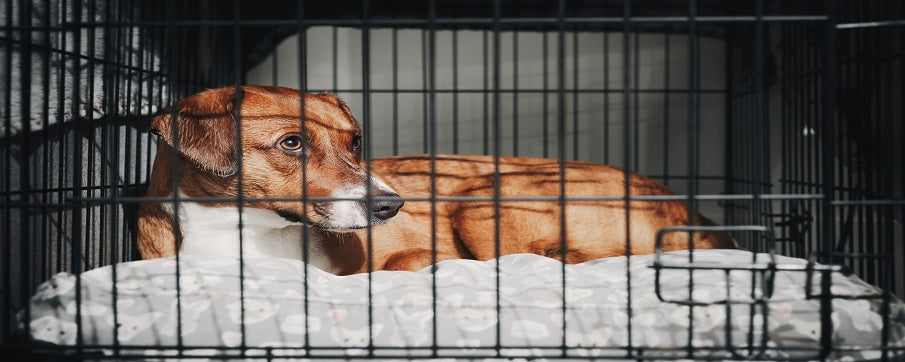
How to Stop Puppy Crate Whining
Share
There is nothing more heart-rendering than a puppy crying. But before you rush to let them out of their crate, remember that effective guidance during these early months in a puppy's life will pay you dividends for many years. Good crate training will pay off, so persevere, and your puppy's whines will fade.
Why Do Puppies Cry in Their Crate?
While it is an exciting time bringing a new puppy home, it is important to remember that your puppy may not be as excited as you! He will have been taken away from his brothers and sisters and away from his mum. Your house will be full of new smells and strange people. If he is placed in a cold crate by himself, it is unsurprising that he cries. Puppies cry to communicate with you. He may be telling you that he needs a wee, or that he is cold, or that his teeth are hurting. Sadly, we hear all this communication as simply an annoying noise. If we can understand why he is crying, we can reduce the crying.
Is It Normal for a Puppy to Cry in His Crate?
It is completely normal for a pup to cry in his crate. Puppies are sociable creatures who want to join in the fun. Being shut in a crate away from people differs from their idea of a good time. Dogs are pack animals, so keeping your puppy's crate where he feels still part of the pack is important. The sitting room is often the best place, with another crate in your bedroom for bedtime. This way, your pet won't feel alone and will feel comfortable in his crate. Always ensure he has had a wee and a good play before putting your puppy in his crate.
Tips To Help Your Puppy Stop Crying
Remember that a puppy's cry is designed to get your attention. The cry is to alert his pet parents, and it needs to be annoying and make you react; otherwise, it wouldn't work! Do not tell your puppy off to make them stop crying; she is not being naughty; crying is an entirely natural function. However, we don't want to encourage crying, so good puppy training will help prevent the whine from escalating. Don't let him out when he is crying. Make sure he is quiet and settled when you let him out. Ensure you put him in his crate once he has toileted and exercised. Make sure you make the crate inviting and comfy, with a soft bed and some toys. Leave him in there for a short time in the beginning. You need to put him in his crate for lots of short periods and praise him when he is quiet.
Common Crate Training Mistakes to Avoid
The most common mistake that people make is trying to increase the time they leave their puppy in the crate too quickly. Remember, if your puppy starts whining, you may increase the time too quickly. Reduce the time again until he is happy, then rebuild it slowly. Most training issues can be rectified by going back a few steps. The other common issue is reacting to the whining. If you shout at your puppy whining, he has received a response to his noise. He won't understand that you are shouting at him. If you find it annoying, remove yourself from the situation; this is the first time anyone has managed to train a dog by getting annoyed at it.
Dealing with A Puppy's Persistent Whining
Persistent whining can be tricky. If you are getting increasingly frustrated by your puppy's whining, it may be time to consult a professional. With a consistent and effective training schedule, whining will reduce over time, but it can be slow with some puppies. Remember that the benefits of crate training will pay off, and having a dog that can be safely shut out of the way will be useful for many years to come. If you are struggling with the whining, take it back to the beginning and reintroduce the crate slowly, for short periods, with much praise when he is quiet. Positive reinforcement of good behaviour is always better than reprimanding the bad. Small steps and small increases are key to building up good behaviour.
When Is It Time To Worry?
Consulting a professional is always wise if you are worried about your puppy's behaviour. Some dogs do become extremely distressed and can try to escape, even to the point of hurting themselves in their efforts to be free. Whilst we try to buy puppies from good breeders, you could have unknowingly bought a puppy from a farm that has already been created in an unpleasant environment. So, his association with his crate may be negative. If you think the level of distress your puppy is exhibiting seems more than you would expect, then seek professional help.
Don't Let Puppy Crying Stop You Crate Training
We all know how agonising it can be to hear a puppy cry. However, remember that normally, this period is short-lived, and your puppy will soon be used to his crate and will happily regard it as his safe place. Maintain consistent training and increase his crate time gradually, and you should be rewarded with a happy and well-behaved puppy. As with all training methods, there may be a better fit for your puppy, which may develop faster or slower than you expected. You must find the method that works best for you and your family. If you are looking for a crate ready for the arrival of your puppy or are looking for a larger crate for your growing bundle, then take a look at our range of crates here or our small puppy crates here, or if you just want some advice, then call our experienced team on 01942 316 431



